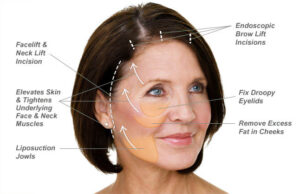
In this day and age, we have a “gotta have it yesterday” mentality. Information is sent around the world in microseconds, packages are shipped overnight, and we can even microwave dinner in three minutes. We’re always on the go, multitasking, working even more than before. We are taking the kids from school to soccer practice, music lessons, and home for dinner, and then we have our regular tennis leagues.
I see many patients who are concerned about facial aging. They look older than they feel and want to stay youthful and, in many instances, competitive. They often look for quick fixes. When I was a plastic surgery resident 25 years ago, the only treatment methods for the aging face were a facelift surgery, forehead lift, and blepharoplasty eyelid surgery . Patients were either a candidate or not. Since that time, our understanding of facial aging has increased dramatically. We now understand that over one’s lifetime, you can lose as much as 50% of your facial fat. In addition, the skin becomes lax and the cells are unable to retain water. This all contributes to the face sagging, with the development of jowls, loose neck skin, prominent nasolabial folds, bags under the eyes, and drooping eyebrows.
Physicians are now not only resecting the loose skin, but also adding volume to the face, with different types of fillers including fat, hyaluronic acid, and collagen. In addition, the face lifting procedures have expanded in techniques, to include limited dissection facelifts, thread lifts, and multi-plane facelifts. This not only gives the patient many alternatives but also contributes to confusion as to what is the best choice.
 As I have mentioned before, it’s important to seek a qualified plastic surgeon, if you are a candidate for a facelift. There are many practitioners, who are not board-certified plastic surgeons, offering “nonsurgical facelifts” as well as limited facelifts that they advertise will give you the same result as the more traditional surgical facelifts. Ask them what their qualifications are, if you can see before and after pictures, and if you can speak with some of their former patients. The more traditional facelifts will last 7-10 years. The limited facelifts and “liquid facelifts” will not give as effective a result, nor will they last nearly as long. In my practice, I utilize 3-4 different types of facelifts, depending on the patient’s needs, and I often will complement the facelift procedure with dermal fillers, Botox, and laser resurfacing. Some patients really do not want surgery, even though that may be the best treatment method. In this situation, I explain to them alternative treatments and their limitations. There is no “one-size-fits-all formula” to treat the aging face.
As I have mentioned before, it’s important to seek a qualified plastic surgeon, if you are a candidate for a facelift. There are many practitioners, who are not board-certified plastic surgeons, offering “nonsurgical facelifts” as well as limited facelifts that they advertise will give you the same result as the more traditional surgical facelifts. Ask them what their qualifications are, if you can see before and after pictures, and if you can speak with some of their former patients. The more traditional facelifts will last 7-10 years. The limited facelifts and “liquid facelifts” will not give as effective a result, nor will they last nearly as long. In my practice, I utilize 3-4 different types of facelifts, depending on the patient’s needs, and I often will complement the facelift procedure with dermal fillers, Botox, and laser resurfacing. Some patients really do not want surgery, even though that may be the best treatment method. In this situation, I explain to them alternative treatments and their limitations. There is no “one-size-fits-all formula” to treat the aging face.
Frequently Asked Questions
Non-surgical facelifts can provide a less invasive alternative to traditional facelift surgery. They typically involve procedures like dermal fillers, laser treatments, or ultrasound therapy to lift and rejuvenate the skin. While they can improve signs of aging to some extent, they may not achieve the same dramatic results as a surgical facelift, especially for more significant sagging or excess skin.
Ideally, someone offering non-surgical facelift procedures should be a licensed and experienced medical professional, such as a dermatologist, plastic surgeon, or trained aesthetician. They should have specific training and certification in the particular procedures they are performing to ensure safety and effectiveness.
Your expectations for facial rejuvenation should be realistic and aligned with the capabilities of the procedures you choose. Non-surgical options can improve skin texture, reduce wrinkles, and enhance facial contours, but they may not completely reverse all signs of aging or provide permanent results.
Combining different procedures, both surgical and non-surgical, can often provide more comprehensive and customized results. For example, combining Botox injections with dermal fillers or laser treatments may address multiple aspects of facial aging, such as wrinkles, volume loss, and skin laxity.
- Surgical facelift: Requires anesthesia, recovery time, and carries risks associated with surgery such as infection and scarring. Results can be long-lasting but not permanent as aging continues.
- Non-surgical facelift: Provides temporary results and may require multiple sessions for optimal effect. Cannot address severe sagging or excess skin as effectively as surgery.

